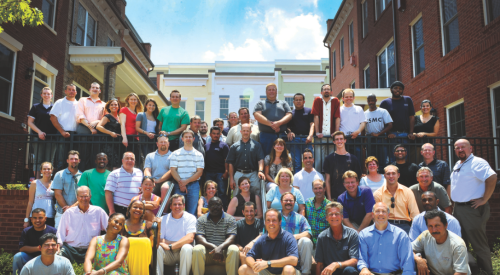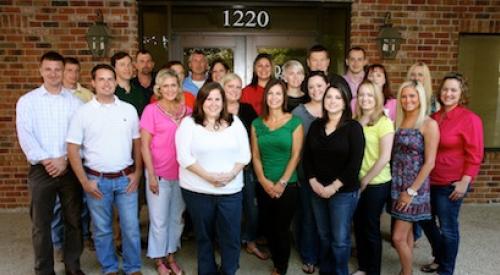| Leadership: The management team at Simonini Builders Inc. includes (from left) vice president/construction Phil Hughes, president and CEO Alan Simonini, vice president and CFO Ray Killian and vice president/operations and controller Bill Saint.
|
Culturally, Simonini Builders Inc. is the perfect mix of entrepreneurial independence and corporate constraint. At this Charlotte, N.C.-based firm, these two opposites blend beautifully, and the result is a company totally in tune with its customer and perfectly positioned for growth. Second-generation owners — president and CEO Alan Simonini and vice president and chief financial officer Ray Killian — have married their vision and values with people and processes to create an organization that is built to last. Already large among luxury custom builders with 43 closings for $39.5 million in revenue in 1999, SBI is poised for still more.
Creating a company ready for the opportunities — and the obstacles — in the luxury home market was the goal that launched SBI’s management revolution. The hoped-for outcome of this undertaking:
- transform Simonini Builders from a family-run enterprise into a true business with strategic plans, goals and objectives, but to do so in a way that combines the best of both cultures.
- create a team of employees and trade contractors who support each other, both in their professional development and personal growth.
- put before every team member — including the customer — a computer system that provides the information he or she needs to satisfy a client the first time, every time.
SBI’s results, both in the marketplace and within the company, more than validate the efforts of its 35 team members to create a company that makes good on its mission: to deliver superior-quality homes, outstanding customer service and to forge relationships with clients built upon trust. Yet there isn’t a person within the organization who believes that his or her part in making good on this mission is done. The very culture of the company as well as its values requires that each person in every department seek the training and skills necessary to support and satisfy some very particular customers and to forever "raise the bar."
Custom Quality
At Simonini Builders, custom quality has everything to do with implementation and absolutely nothing to do with execution. On the implementation side, this Gold Award winner demonstrates that quality business practices don’t have to require the formality often associated with total quality management. On the execution side, absolutely the opposite is true — quality and thus customer satisfaction are the direct results of detailed planning, effective communication and the data necessary to measure performance and plot improvement.
To fulfill SBI's mission — to create a company built to last — senior leaders Simonini, Killian, vice president/operations and controller Bill Saint, and vice president/construction Phil Hughes rely on a mixture of methods that combine formal and casual, and begin before an employee is even hired. Job applicants go through an exhaustive battery of tests and interviews before they join the company. SBI uses this pre-employment screening process to ensure that it hires only those individuals who can succeed in a highly entrepreneurial environment. The exact type of testing depends on the position, though every applicant is evaluated on his or her problem-solving ability.
| Construction Quality: Weekly construction staff meetings are a forum for sharing best practices throughout the company.
|
Hiring the right people, setting their goals and creating the processes to achieve those goals is the company's way of ensuring that SBI becomes the builder of choice in its Charlotte market. Each of the company’s 35 team members has written job descriptions and meets regularly with his or her team leader to set individual goals as well as department objectives. That is the formal part of the program. The less structured side is the daily conversation, casual communication and constant give-and-take that occurs naturally in a smaller organization. "We don’t stand on formality around here or have individual agendas," explains Killian. "With the right people with the necessary skills in each position, there is enough back-and-forth to know where everyone is at any given time."
While the give-and-take does provide the management team with the pulse of its people at any point in time, SBI relies on a whole host of reports and measurements that monitor not only human workload but the company’s performance against goals and budget on a monthly or quarterly basis. These include:
- Construction load by superintendent: After much review, SBI has found that the best measure of workload for its 10 builders is the number of square feet under construction at any given time. For optimal performance, SBI tries to keep each superintendent around the 30,000-square-foot benchmark and works to never exceed a 50,000-square-foot maximum target. This monthly report is used to identify and balance workloads.
- Construction status: This weekly report reviews every job according to schedule, phase, issues, comments, etc., and ensures complete communication between the entire construction team as well as everyone in the company.
- Estimate tracking report: Also critical to workload balance, this report lists every prospect that is in the estimate process. Simonini maintains 20,000 to 35,000 square feet per estimator and requires that no final estimates be given without full detailed takeoffs.
- Closings by superintendent: This report graphs the gross profit and total square footage closed for each period. SBI uses it to identify efficiencies in the construction process and highlight profitable practices that can be shared throughout the company.
- Profit analysis by house: Review of every job that compares actuals against the estimate with changes.
- Post-closing survey summary: Identifies ratings on client expectations and product quality.
- Warranty tracking summary: Lists all open warranty jobs and cycle time. While the primary goal of this report is to ensure better customer satisfaction, it also has helped SBI identify product issues as well.
Constructed Quality
While quality construction is nothing new at SBI, the means of ensuring it — as well as the definition of it — continue to evolve. "Quality is defined by the customer first and the company second," says Simonini, "and that order is the most important thing for us to remember."
Communication is the foundation for quality at Simonini Builders. While paramount in all home building, clear communication that accurately sets buyer expectations is critical to a luxury custom builder such as SBI that never builds the same home twice. To ensure that all clients receive the attention and the answers they need, SBI uses a team-based relationship with all customers. In the initial sales process, the salesperson — either Simonini, Killian or one of two dedicated salespeople — meets with the clients and introduces them to their proposed construction team, the superintendent and estimator. During the meeting, the superintendent uses a prepared presentation to walk prospects through the process of building a custom home. The estimator and salesperson continue the communication during the pricing process, working with the customers to identify the spaces and features that matter most to them.
The development of PowerPoint presentations for key meetings with customers is a new, though already key, part of the company’s customer satisfaction efforts. "The most important thing we can do for our customers is help set the expectation on what will be included in their home and then simplify the construction process for them," explains Saint. "Because each home is so custom in nature, the client can’t walk through a builder model and see what the plumbing fixtures, lighting, hardwoods, mantle, etc., will look like. This can cause a lot of anxiety."
To ease this anxiety and answer questions before they occur, SBI gives every client a "Homeowner’s Companion Manual," a 250-page book that describes each phase of the construction process — planning, selections, pricing, loan, construction, closing, warranty and maintenance. In addition, a step-by-step road map is reviewed at the pre-construction meeting.
While the construction process itself intimidates a lot of clients, the product selection process often proves just as overwhelming. Beyond the assistance of its own sales staff, SBI employs a team of professional interior designers who are subcontracted to meet with each client and assist with the color and product selection process.
| Performance Management: Warranty manager Ed Palmer tracks service request histories daily.
|
Setting expectations and smoothing out the rough parts form one component of SBI’s customer satisfaction strategy. The other is regular communication — both among team members and with the customer. Internally, SBI holds regular staff gatherings to ensure that every person in the company has the information necessary to assist every customer. The weekly meeting schedule includes:
- Monday morning full-staff reviews of every job in progress, each house in the estimating pipeline, as well as the status of every current prospect.
- construction gatherings on Wednesday. Part of each weekly meeting is a review of a construction quality issue — window flashing, waterproof decks, etc. Other activities include a presentation by a building product manufacturer, a product-and-service update by a trade contractor and a discussion of construction issues from the warranty manager.
- Thursday sessions with the warranty team in which the three-person department reviews service history and cycle time. SBI’s goal is an immediate acknowledgement of all warranty requests and quick repairs. Despite a 45-50% increase in the number of homes under warranty, completion times have fallen from 75 days in 1996 to 18 days at present.
- estimating also meets on Thursday to review work in the pipeline and fine-tune the customer communication process during this construction phase.
The goal of these early-morning meetings: Learn as a company from recent successes or failures and review upcoming events.
Clients receive the same scheduled attention. Beyond the pre-construction meeting, each client will be contacted at specific intervals, including:
- site review before digging
- a letter at time of start to verify dates
- pre-drywall meeting at the site
- phone communication from the salesperson three and six months into the building process
- pre-landscape meeting at the site
- orientation
- final review
Each meeting, call or letter is triggered automatically by the company’s in-house database system, Structure. "This technology lets us formulate an action program for our customer communication and have a device to ensure it would be triggered and executed easily," says Saint.
In addition, either Simonini or Killian calls each customer a minimum of four times throughout the home building process. "This is just one way of making sure that our relationship gets off on the right foot," says Killian.
The attention to quality — both in its communication and construction — is earning SBI high marks from its customers. In post-closing surveys conducted by Woodland & O’Brien, Simonini Builders has received a 100% "willing to refer" rating — its gauge of overall customer satisfaction — for the past two years. The company also sends internally generated surveys to customers three times during the construction and after each warranty service. These surveys ask only five key questions, such as, "How are we meeting the expectations we set during the sales process?" Results of all surveys are shared throughout the organization during weekly meetings.
Compensating Quality
SBI’s compensation program rewards performance. All employees participate in a bonus plan based on budgeted sales, starts and closing numbers per quarter. "We picked these things because they are easy to measure," explains Killian. "Budgets are set for each annually, and meeting those goals depends on the overall success of our key drivers. If workloads are balanced properly, closings will occur as planned. If client expectations are properly set, customer satisfaction will improve and referral sales will result, which drives a large part of our sales volume."
Construction superintendents share in two other performance-based bonus programs. The first is based on meeting a home’s budget, schedule and achieving constructed quality targets. Additionally, they receive a quarterly bonus based on the average of the prior quarter’s customer satisfaction scores. Combined, these bonuses average more than 20% of a superintendent’s salary.
| Supplier Partnerships: Vice president/construction Phil Hughes reviews job specifications with trade partners.
|
SBI's investment in people — in dollars, time and training — doesn’t stop at its own employees. The company works with a small group of trade contractors and has long-standing relationships with most of them. While price is certainly a factor in selecting a supplier, Hughes looks more at the operational abilities and processes of the supplier.
"A company’s ability to streamline the construction process and work efficiently carries a lot of weight," says Hughes. "The complex nature of our type of home building makes this critical."
Equally important to SBI is a supplier’s ability to work directly and professionally with the home buyer. "We really hand-hold our clients throughout the building process," explains Simonini, "and we need suppliers who can professionally communicate and deliver upon client expectations."
To make this job easier for each trade partner, SBI has a written agreement that outlines its specific quality standards. Each contractor must sign this document before starting work for the company.
Because so many of SBI's relationships with its suppliers are long-standing, a team atmosphere prevails at the job site. "Our trade partners know how to work with each other and know what we expect of them," says Simonini. "They take our quality standards to heart and understand that the satisfaction of our customers has a direct impact on the long-term health of their companies."
Quality Profits
Building a company to last must be done by people, but their efforts must be supported by processes and systems that make growth possible — without adding significantly to overhead with more staff. With the Structure system as its technology foundation and a clear vision of its goals, SBI has increased sales by 50% with only a 10% increase in workforce from 1997 to 1999. During the past 14 months, productivity has risen from an average of $2.6 million in construction per superintendent to $4 million in construction at any one time. Killian cites more efficient systems, better resource allocation and continual training for these increases.
The gains posted to date are the foundation for those yet to come. SBI plans to grow in staff and in skills to prepare for an expansion beyond Charlotte to Charleston, S.C., in the next year.
"We’re building our company the way we build a house," says Killian, "a solid foundation to support a lot of activity within."











